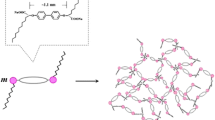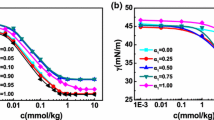Abstract
Decondensation of DNA molecules, previously compacted by cationic gemini surfactant 12-3-12 · 2Br, has been successfully achieved by introducing triblock copolymer (PEO)20–(PPO)70–(PEO)20 (P123). P123 can interact with 12-3-12 · 2Br to form supramolecular assemblies through hydrophobic interactions, while not interacting with DNA. When introducing 12-3-12 · 2Br into P123/DNA system, the presence of P123 will inhibit the formation of DNA/12-3-12 · 2Br complexes due to the stronger interaction between P123 and 12-3-12 · 2Br. For previously formed DNA/12-3-12 · 2Br complexes, the addition of P123 can lead to the release of DNA from the complex, which should be attributed to the complexation of P123 with free 12-3-12 · 2Br surfactants in bulk phase followed by the breakup of the thermodynamic equilibrium between surfactant aggregates associated with DNA and free surfactants in bulk phase. CD experiments reveal that 12-3-12 · 2Br can change the conformation of DNA from typical B-form to ψ-phase by formation of DNA/12-3-12 · 2Br complexes. However, the release of the surfactant from the complex induced by P123 turns DNA conformation from ψ-phase back to B-form.










Similar content being viewed by others
References
Sarraguça JMG, Dias RS, Pias AACC (2006) Coil-globule coexistence and compaction of DNA chains. J Biol Phys 32:421–434
Miguel MG, Pais AACC, Dias RS, Leal C, Rosa M, Lindman B (2003) DNA-cationic amphiphile interactions. Colloids Surf A Physicochem Eng Asp 228:43–55
Estévez-Torres A, Baigl D (2011) DNA compaction: fundamentals and applications. Soft Matter 7:6746–6756
Lungwitz U, Breunig M, Blunk T, Göpferich A (2005) Polyethylenimine-based non-viral gene delivery systems. Eur J Pharm Biopharm 60:247–266
Hackl EV, Kornilova SV, Blagoi YP (2005) DNA structural transitions induced by divalent metal ions in divalent metal ions in aqueous solutions. Int J Biol Macromol 35:175–191
Sarraguça JMG, Pais AACC (2006) Polyelectrolytes in solutions with multivalent salt. Effects of flexibility and contour length. Phys Chem Chem Phys 8:4233–4241
Grueso E, Cerrillos C, Hidalgo J, Lopez-Cornejo P (2012) Compaction and decompaction of DNA induced by the cationic surfactant CTAB. Langmuir 28:10968–10979
He Y, Shang Y, Shao S, Liu H, Hu Y (2011) Micellization of cationic gemini surfactant and its interaction with DNA in dilute brine. J Colloid Interface Sci 358:513–520
McLoughlin D, Langevin D (2004) Surface complexation of DNA with a cationic surfactant. Colloids Surf A Physicochem Eng Asp 250:79–87
Zana R (2002) Dimeric and oligomeric surfactants. Behavior at interfaces and in aqueous solution: a review. Adv Colloid Interf Sci 97:205–253
Karlsson L, van Eijk MCP, Söderman O (2002) Compaction of DNA by gemini surfactants: effects of surfactant architecture. J Colloid Interface Sci 252:290–296
Bhadani A, Singh S (2009) Novel gemini pyridinium surfactants: synthesis and study of their surface activity, DNA binding, and cytotoxicity. Langmuir 25:11703–11712
Wettig SD, Badea I, Donkuru M, Verrall RE, Foldvari M (2007) Structural and transfection properties of amine-substituted gemini surfactant-based nanoparticles. J Gene Med 9:649–658
Zana R (2002) Dimeric (Gemini) surfactants: effect of the spacer group on the association behavior in aqueous solution. J Colloid Interface Sci 248:203–220
Badea I, Verrall R, Baca-Estrada M, Tikoo S, Rosenberg A, Kumar P, Foldvari M (2005) In vivocutaneous interferon-gamma gene delivery using novel dicationic (gemini) surfactant-plasmid complexes. J Gene Med 7:1200–1214
Carlstedt J, González-Pérez A, Alatorre-Meda M, Dias RS, Lindman B (2010) Release of DNA from surfactant complexes induced by 2-hydroxypropyl-beta-cyclodextrin. Int J Biol Macromol 46:153–158
Jorge AF, Dias RS, Pais AACC (2012) Enhanced condensation and facilitated release of DNA using mixed cationic agents: a combined experimental and monte carlo study. Biomacromolecules 13:3151–3161
Dias RS, Lindman B, Miguel MG (2002) Compaction and decompaction of DNA in the presence of catanionic amphiphile mixtures. J Phys Chem B 106:12608–12612
González-Pérez A, Dias RS, Nylander T, Lindman B (2008) Cyclodextrin-surfactant complex: a new route in DNA decompaction. Biomacromolecules 9:772–775
Cao M, Deng M, Wang X, Wang Y (2008) Decompaction of cationic gemini surfactant-induced DNA condensates by beta-cyclodextrin or anionic surfactant. J Phys Chem B 112:13648–13654
Corbyn CP, Fletcher PDI, Gemici R, Dias RS, Miguel MG (2009) Re-dissolution and de-compaction of DNA-cationic surfactant complexes using non-ionic surfactants. Phys Chem Chem Phys 11:11568–11576
Gebhart CL, Kabanov AV (2001) Evaluation of polyplexes as gene transfer agents. J Control Release 73:401–416
Hao J, Sha X, Tang Y, Jiang Y, Zhang Z, Zhang W, Li Y, Fang X (2009) Enhanced transfection of polyplexes based on pluronic-polypropylenimine dendrimer for gene transfer. Arch Pharm Res 32:1045–1054
Singh PK, Kumbhakar M, Pal H, Nath S (2008) Effect of electrostatic interaction on the location of molecular probe in polymer-surfactant supramolecular assembly: a solvent relaxation study. J Phys Chem B 112:7771–7777
Kumbhakar M (2007) Aggregation of ionic surfactants to block copolymer assemblies: a simple fluorescence spectral study. J Phys Chem B 111:14250–14255
Jansson J, Schillén K, Nilsson M, Söderman O, Fritz G, Bergmann A, Glatter O (2005) Small-angle X-ray scattering, light scattering, and NMR study of PEO–PPO–PEO triblock copolymer/cationic surfactant complexes in aqueous solution. J Phys Chem B 109:7073–7083
Zana R, Benrraou M, Rueff R (1991) Alkanediyl-α, ω-bis(dimethylalkylammonium bromide) surfactants. 1. Effect of the spacer chain length on the critical micelle concentration and micelle ionization degree. Langmuir 7:1072–1075
Izumrudov VA, Zhiryakova MV, Goulko AA (2002) Ethidium bromide as a promising probe for studying DNA interaction with cationic amphiphiles and stability of the resulting complexes. Langmuir 18:10348–10356
Zhou Y, Li Y (2004) Studies of interaction between poly(allylamine hydrochloride) and double helix DNA by spectral methods. Biophys Chem 107:273–281
Alexandridis P, Holzwarth JF, Hatton TA (1994) Micellization of poly(ethylene oxide)-poly(propylene oxide)-poly(ethylene oxide) triblock copolymers in aqueous solutions: thermodynamics of copolymer association. Macromolecules 27:2414–2425
Zhao X, Shang Y, Hu J, Liu H, Hu Y (2008) Biophysical characterization of complexation of DNA with oppositely charged Gemini surfactant 12-3-12. Biophys Chem 138:144–149
Acknowledgments
This work is supported by the National Natural Science Foundation of China (Project No. 21173079), the 111 Project of Ministry of Education of China (No. B08021), and the Fundamental Research Funds for the Central Universities.
Author information
Authors and Affiliations
Corresponding author
Rights and permissions
About this article
Cite this article
He, Y., Xu, S., Sun, D. et al. Decondensation of cationic gemini surfactant-induced DNA aggregates using triblock copolymer (PEO)20–(PPO)70–(PEO)20 . Colloid Polym Sci 291, 2139–2146 (2013). https://doi.org/10.1007/s00396-013-2954-5
Received:
Revised:
Accepted:
Published:
Issue Date:
DOI: https://doi.org/10.1007/s00396-013-2954-5




